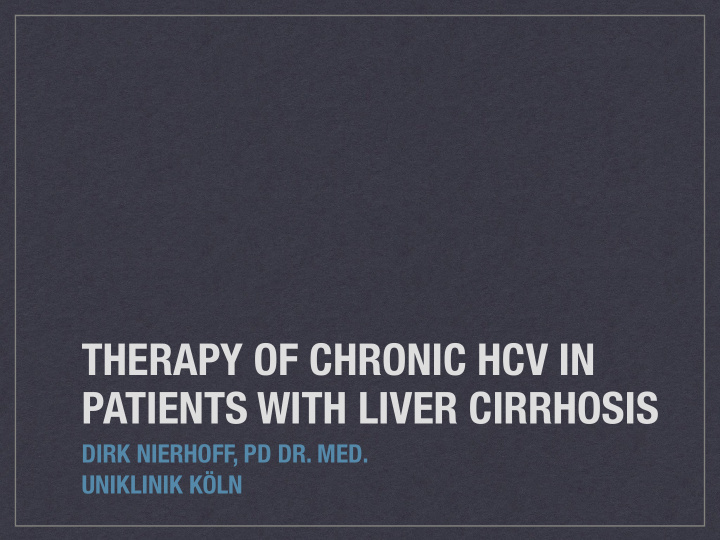



THERAPY OF CHRONIC HCV IN PATIENTS WITH LIVER CIRRHOSIS DIRK NIERHOFF, PD DR. MED. UNIKLINIK KÖLN
Natural disease course in liver cirrhosis
Optimist-2: SOF + SIM � � � � � � � � � � � � � � � � � � � � � � � � � � � � � � � � � � � � � � � � � � � � � � � � � � � � � � � � � � � � � � � � � � - SAEs in 5% of patients - 1 patient died in traffic accident - No hepatic decompensation FIG. 2. SVR12 by baseline NS5A and Q80K polymorphisms (intent-to-treat population). Lawitz E, et al. EASL 2015. Abstract LP04. Published 19.02.2016
ALLY-1: DAC + SOF + RBV
Phase 2/3 integrated Analysis of LDV/SOF +/- RBV
TURQUOISE-II: OBV/PTV/r+DSV+RBV
TURQUOISE-III: OBV/PTV/r+DSV+RBV
FDA Drug Safety Communication: FDA warns of serious liver injury risk with HCV treatments Viekira Pak and Technivie Reported cases typically occurred within one to four weeks of initiating therapy and were characterized by the acute onset of rising direct serum bilirubin levels without ALT [alanine aminotransferase] elevations in association with clinical signs and symptoms of hepatic decompensation.
Pooled safety analysis: OBV/PTV/r+DSV+RBV
Phase 2/3 integrated Analysis Grazoprevir + Elbasvir Treatment Experienced (n=233) Treatment Naive (n=169); 12 Wks 100 98 90 94 89 91 100 100 80 80 SVR12 (%) SVR12 (%) 60 60 Advantage for Non-Responder 40 40 with RBV and 16w. 135/ 28/ 48/ 74/ 46/ 49/ 20 20 138 31 54 81 49 49 n/N = n/N = 0 0 RBV No RBV RBV No RBV RBV No RBV 12 wks 16 or 18 wks Jacobson et al., AASLD 2015; O#42+LB22
ASTRAL-1: Sofosbuvir + Velpatasvir
Decompensated liver cirrhosis
Astral-4: Decomp. liver cirrhosis Sofosbuvir + Velpatasvir Open-label, ~90% Child B, ~80% Aszites, ~60% HE, MELD Median 10; HCC/LTx excluded MELD>15: 84% better, 8% worse after SVR; MELD <15: 52% better, 27% worse after SVR AEs konsistent with liver cirrhosis und ribavirin toxicity SOF/VEL 12 wks SOF/VEL + RBV 12 wks SOF/VEL 24 wks 96 100 100 85 94 92 88 100 86 86 83 50 50 80 SVR12 (%) 60 40 7/ 11/ 6/ 8/ 6/ 6/ 20 75/90 82/87 77/90 60/68 65/68 65/71 14 13 12 8 6 7 n/N = 0 3 2, 4, and 6 1 All Pts HCV Genotype Charlton MR, et al. AASLD 2015. Abstract LB-13. Curry MP, et al. N Engl J Med. 2015;[Epub ahead of print].
Conclusion I DAA therapy in compensated liver cirrhosis is safe. SVR12 in all combinations > 90 - 100%. In decompensated liver cirrhosis protease inhibitors should be avoided. SVR12 rates are significantly lower.
But what about safety in the real world? And what happens to liver cirrhosis after SVR12?
Hepa-C-Registry (Spanien)
UK EAP Advanced liver cirrhosis
UK EAP Advanced liver cirrhosis
UK EAP Advanced liver cirrhosis
UK EAP Advanced liver cirrhosis
Hepa-C-Registry (Spanien) MELD 18: 3 M-Mortality 11%!
Final conclusion In compensated cirrhosis DAA therapy is safe with high SVR12-rates. In decompensated cirrhosis SVR12 rates are significantly lower Severe AEs more common with higher MELD. Consider listing before start of therapy! Only a minority of patients with CP-C achieve long-term benefit. Consider therapy after liver transplantation!
Hepa-C-Registry (Spanien)
Komp. LCI und Real- World?
Dekomp. LCI und Real- World?
Recommend
More recommend